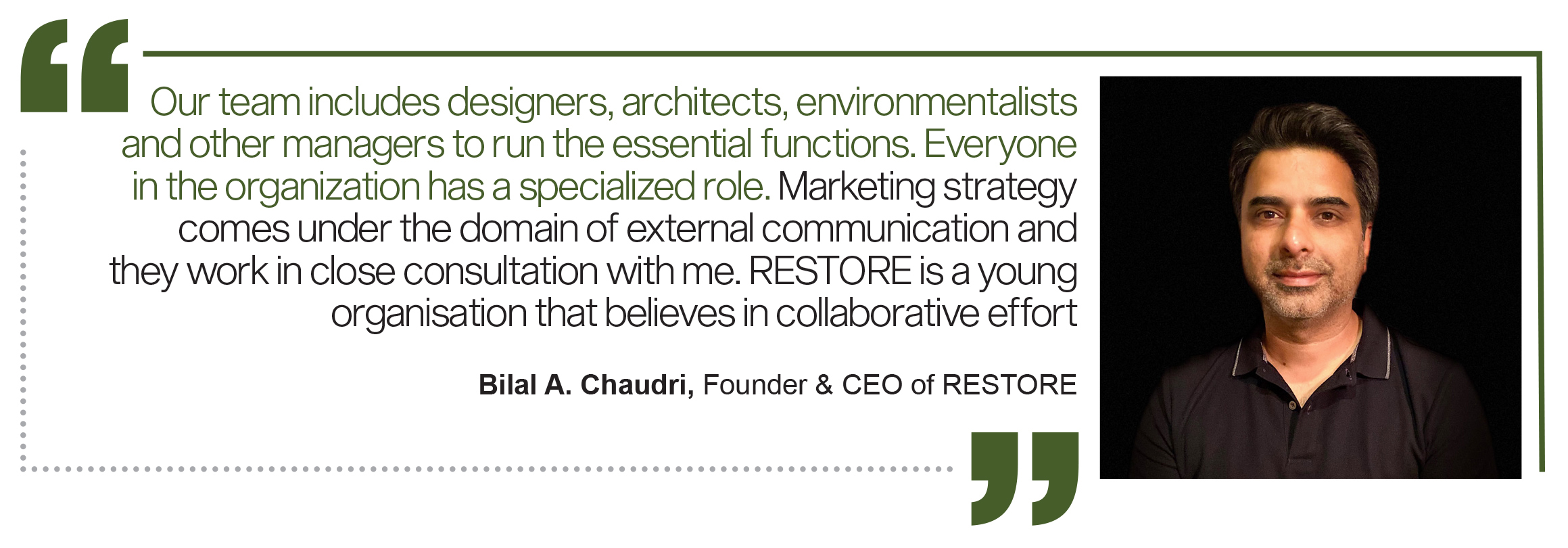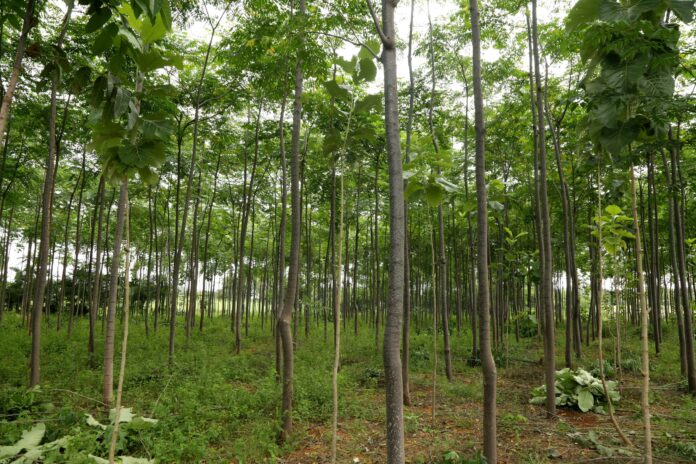In May 2016, under the pro-development and pro-infrastructure auspices of the then Punjab Chief Minister Mian Shahbaz Sharif, the corridor between Lahore’s Liberty roundabout in Gulberg all the way to Shadman via Jail Road was turned into a signal free corridor.
This patch of road in the provincial capital was one of the busies, messiest, and most chaotic stretches of the entire City. While the time it took to complete the project was a nuisance, at the end of it, Lahoris breathed a sigh of relief. And this was not the first one, especially since similar projects by the Sharif administration had gotten similar results. However, blinded by the comforts offered by the road, nobody noticed the damage that had been done to Lahore’s urban horticulture.
The Signal Free Project consumed 196 trees along the route from Liberty roundabout to Shadman’s Fawara Chowk, and it was not even the only project decimating greenery in the City. For the Lahore Orange Line Metro Train Project, 620 grown-up trees were felled on its 27.1km long route from Dera Gujran to Ali Town. The authorities also started uprooting about 1,300 trees for the Canal Road widening project at three stretches. For the Link Canal Road from Punjab University land Via Kareem Block, completed about two years ago, 120 trees, a majority of them of mango, were removed. Likewise, another mega project – the Elevated Expressway Project from Gulberg to the Motorway – caused the uprooting of over 1,700 trees.
As much as any cultural marker, Lahore’s trees are a symbol of the City’s history and a thing of pride for its residents. Lahore’s trees have been a major victim of the City’s impressive development in the past decade. It has also been in this time that Lahore has the dishonour of becoming the most polluted city in terms of air in the entire world. While this has more to do with coal based power plants, the absence of trees only exacerbates the effects. It is the age old question, is development worth it at the expense of our environment? To this end, the incumbent government has made efforts to not just restore but increase Lahore’s green area.
In the past, government’s have tended to plant easy shrubs and quick growing trees not necessarily helpful to the environment. But recently, Prime Minister Imran Khan launched an urban forestry programme on the lines of Miyawaki technique in Japan where the trees grow 10 times faster and 30 times denser, and offer protection from air pollution. The first center for this has been the Liberty round about, which only five years ago had to go through the destruction of its trees. How effective is this technique, and can Lahore become a successful model for the rest of the country in this regard? Profit investigates.
The Miyawaki technique
One of the most pressing yet undermined issues we have today is deforestation. Massive efforts have been made to rehabilitate former forest land that has been stripped bare for logging and other commercial activities. However, the biggest cause of forest covered areas disappearing is rapid urbanization. However, while further urban expansion needs to be controlled, one of the ways to reclaim some forestation is to enact plans in which cities and forests can coexist.

This is where the Miyawaki technique comes into play. The Miyawaki afforestation method is a unique way to create an urban forest and is pioneered by Japanese botanist Akira Miyawaki. … In the Miyawaki technique, various native species of plants are planted close to each other so that the greens receive sunlight only from the top and grow upwards rather than sideways.
If you want to be eco-friendly, help biodiversity and reduce your carbon footprint, growing a small forest sounds like a great idea. How much space do you think you need for this activity? If your answer is more than an acre, you should think again because through the Miyawaki technique you can grow a sustainable forest in a few hundred square feet.
In fact, there is a story behind the Miyawaki forest, or Miyawaki methodology that began in the 1960’s when a Japanese botanist, Akira Miyawaki, used the methods of mapping potential natural vegetation (PNV) and found traces of ancient forests that still surround most of Japan’s temples and shrines. Miyawaki later did more research and introduced a technique that helped create dense and ancestral forests. Experts believe that with this technique, big cities can be rejuvenated very quickly.
Since the methodology can be used for urban forestry by growing more and more forests in less time and in less space, many countries of the world are using it now. In Pakistan, the pioneering work has been done in the private sector, starting with an urban forest that was first created in Karachi in 2016. In January of 2020, a private firm named RESTORE created a 10,000 saplings forest in collaboration with LDA in Lahore’s Liberty Market. The project was sponsored by Izhar Monnoo Developers, a well-known real estate firm who had previously made a Miyawaki Forest in one of their housing schemes. It was looking at the success of this project that Imran Khan announced this new project.
Highlighting the success of Liberty Market Forest recently, he launched an urban afforestation campaign starting with the decision to plant 51 Miyawaki forests in Lahore. Parks and Horticulture Authority (PHA) in Lahore has been assigned the task to make these forests.
“I have been fascinated with Nature for very long and when I learnt how Miyawaki methodology takes its inspiration from Nature, I started digging deeper into how nature based solutions can help cure some of the most wicked problems our planet faces today,” says Bilal A. Chaudri RESTORE’s Founder & CEO. As he researched the technique, he observed that the methodology had a lot of potential as a business.
“In 2017, I had the opportunity to meet with Shubhendu Sharma, an Indian entrepreneur whose organization had already done some work with urban forests, and the Karachi based company run by a friend and fellow forester Shahzad Qureshi. Shubhendu’s company AFFORESTT has made forests across India as well as in several other countries. He encouraged me to take up this work commercially, even though I had been running a textile and apparel firm since 2003. RESTORE was formally launched in 2018.”
“Initially, the goal was to create public awareness about the benefits of forests in general and urban forestation in particular. As the time passed, we expanded our outreach from private to public sector. RESTORE has completed dozens of projects and our clients now include educational institutions, private housing schemes, healthcare facilities, NGOs, industrial organizations, farmland and private home owners to name a few,” he added.
However, recent times have not been smooth sailing for RESTORE either. While the company experienced steady growth in 2019, the Covid-19 outbreak hit them hard as an afforestation business. In response, they decided to actually diversify and made several trials with agricultural crops applying their learning of the forest ecosystem. The company currently works with several clients as a farm production and management company. As with their forest making methodology, they use no chemical fertilizer or pesticides in farming. The Liberty market project in Lahore, which was recently highlighted by the PM in his speech and on his social media, was the first forest RESTORE had created on public land.

“Not only did RESTORE create this forest, we have been managing it as a company too. While we are glad to see the government’s recently announced initiative in this sector, it is critical that experts of the Miyawaki methodology are consulted in order to ensure long term success and sustainability of these urban forests,” he said, pointing a very obvious finger towards himself and his company.
However, the Chief Operating Officer (COO) of Izhar Mannoo Developers, Sheraz Mannoo, who recently decided to grow the Miyawaki forest in Liberty, told Profit that strategically growing urban forest’s will greatly improve our cities. Growth in urban populations creates opportunities for urban forests to deliver ecosystem services critical to human wellbeing and biodiversity. “Our challenge is to strategically expand urban forests and provide our communities, particularly the vulnerable, with healthier, happier, and enriched lives. Trees are too often removed for urbanization, Urban forests help to filter air and water, control stormwater, conserve energy, and provide animal habitat and shade,” Mannoo said.
“In addition, they add beauty, form, and structure to urban design. I planted my first Miyawaki urban forest at Dream Gardens Lahore with 6,000 trees and then sponsored a second at Liberty Market Park Lahore with 10,000 trees. Both have grown 10 times faster than conventional planting methods and have been very well received by the public and government bodies. My hope is they will take the Miyawaki model forward and plant hundreds of forest all around the country in the next 2-3 years.”
The business end of things
Let us get this straight, RESTORE is doing wonderful work and it is coming at a critical time. However, they are not (and should not be expected) to work as a philanthropic enterprise. Bilal Chaudri is in this because he loved nature, but also because there is serious business potential in urban forestry for the private sector. “We are a for-profit social enterprise. Most of the work we do is in the urban areas where the population is very dense. That is where greening projects are most needed in order to provide a healthy, cleaner and stress free environment for city dwellers. However, it is not an easy business to make a profit because of the common perception that planting trees should be a low cost activity,” he explains.
“The methodology we employ however is very elaborate and intensive in its use of equipment, material and labor, thus requiring a significant one-time investment by the clients. The good thing is that these native tree forests can be made in very small areas, including peoples’ lawns and backyards. Once sustainable, they do not require any maintenance and that is what makes our forests more affordable in the long run. The more important reason to invest in these forests instead of traditional landscaping and lawns with only grass however is their contribution towards a healthy environment.”
From a purely financial standpoint, this might not be a very lucrative business for a private investor with little knowledge to get into. It is also why the government would do well to get the right advice from the right people. Sound knowledge of how the methodology works, significant hands-on experience of forest making on ground, meticulous planning and project management skills are among the essential parameters to run this business successfully. Most importantly, one must be willing to learn and work with nature. “With every new project comes new findings and we keep honing our skills accordingly. Pakistan has one of the world’s lowest forest covers. We also have large-scale desertification in the country. That said, it is always challenging to convince other businesses to pay for a project in which they do not see a tangible return on investment,” says Bilal Chaudhri.
“Our team includes designers, architects, environmentalists and other managers to run the essential functions. Everyone in the organization has a specialized role. Marketing strategy comes under the domain of external communication and they work in close consultation with me. RESTORE is a young organisation that believes in collaborative effort. We welcome other players to come forward and help us in expanding our efforts. We are also looking to partner with retail brands, industrial manufacturers, educational institutions, corporate enterprises, professional bodies, NGOs, civil society, governmental organisations, farming communities as well as volunteer groups and individuals. Recently, we have seen a surge in online inquiries through our website www.restore.green which reflects increasing awareness and interest in our services.”
Speaking about the lack of awareness about the environment Chaudri said, “This problem is not unique to Pakistan. However, the level of awareness has been steadily raised around the world. Climate change is a reality as are its existential threats to humans and all things living. Creating awareness about the importance of native vegetation, healthy soils, water cycle regulation, carbon sink, biodiversity and other ecosystem benefits that forests provide is a core social responsibility our organization performs through our work on the ground.”
What does the government do?
The question that arises now is that if the work of urban forestry is to be done by the private sector, then what are the government departments doing? The Punjab Forest Department, the Punjab Horticulture Authority, and even the Lahore Development Authority are doing no solid work in terms of urban forestry. They plant easy trees and shrubs that suck up precious fresh water and are usually not native to the land. They cause health problems and never really grow the way they are supposed to. Manicured lawns and sculpted grass statues are all papering over massive cracks in the environments of Lahore and other major cities as well.
Take for example the testimony given by an official of Punjab Forest Department who believe that the department is doing a very good job on paper but if we look at the progress of the department with regard to forest development or new forests, in many places the negligence and dishonesty of the responsible officers becomes clear. For example, the official revealed that the Punjab government once started a project to make Forest Park Bahawalpur beautiful and beneficial to the people for which the government had spent RS 190 million but that project failed miserably.
The main objectives of the project were to beautify the local area through the project, but when the project was monitored, it was revealed that no activity was done to beautify the area. Similarly, there was no facility for physical activity for the general public and no activity was done to eliminate pollution.
“Aesthetic area (20 acres) was not developed properly in the park and it was not being maintained. Weeds were present in the area. Survival rate of the aesthetic plants (Pilkin, Melaleuca, Takoma and Calliandra) was very low (ranging between 50% and 63%). Water channels, of the aesthetic area, were full of weeds. Electrification was incomplete in the project area. Transformers were not installed on the electric poles. The lack of proper monitoring mechanism during project implementation was observed,” the official added.
The official went on to say that it was a matter of a project, as well as many other projects on which many observations already exist and can be applied because of the shortcomings in the completion of these projects.“The second issue is the timber mafia. If you look at the northern areas, including Punjab, the people there cut down trees without thinking about the damage,” he said admitting that forests across the country were declining rapidly due to the timber mafia.
“One of the main reasons is poverty, and the other big reason is the collusion of forest department officials with this mafia. In the northern areas, it is common for a person to cut down a tree once a week, which he uses as fuel, while the mafia buys valuable timber from these people at very cheap prices. Now, if we talk to the higher ups of the forest department, they will continue to give different interpretations and make excuses that they are doing their job wholeheartedly and are determined against the timber mafia while the reality is the opposite. The officials of our departments do not even know about the modern techniques of forestry,” he said.
The views of Parks and Horticulture Authority (PHA) sources were also similar to those of the Forest Department official. “An authority like PHA is working as a gardener instead of developing parks or establishing new parks or forests. Unfortunately, the officials here think that just what is available should be watered and a new flower or tree should be planted in it. They have no plan to eradicate environmental pollution from Punjab,” they said.
SM Imran, who is the Vice Chairman of Lahore Development Authority (LDA) and spokesperson of River Ravi Urban Development Project, also believed that the forest department does its work in specific areas, “The Forest Department’s job is not to establish forests in urban areas, but to improve areas or forests for pre-existing forests. Similarly, if we look at the PHA, this authority has been designed in such a way that it has to do only gardening work. However, the PHA has experts and can easily follow the Miyawaki technique if they wish.”
Imran said that the first Miyawaki forest to be created in Lahore was made through the efforts of LDA as LDA had requested the sponsors to contribute their share for this cause. “This is a very interesting technique and can be used to grow trees faster. Miyawaki forests are ideal for the development of urban areas,” he said.
When asked if the Miyawaki forest was also considered necessary in the Lahore master plan, however, Imran replied that the LDA could not do so.“The preparation of the master plan is done by independent consultants and if they propose that Miyawaki forests are necessary for the development of the city, it will definitely be made a part of the master plan. Yes, of course we have proposed some LDA sites where Miyawaki forests can be grown and if that happens then the control of these forests will be handed over to PHA later.”
What we should be doing
The solution here, of course, is not what the LDA is doing. We need to stand up and say goodbye to standalone grassy grounds, manicured lawns, exotic plants and invidious tree species that have the endless thirst for our precious water resources. Pakistan needs to grow native trees that are not taxing for the environment and sustain themselves while lending aesthetic value to your property. There are as many as 50 different species planted in as little as 100 meters square. You can choose to have forest patches made up of predominantly flowering, bird-attracting, fruiting, ancient-native, or just randomly mixed species. Factories, residential communities and private homes are the best candidates for our forest gardens.
“Our coverage is minimum 10 square meters, and there can be patches up to 500 square meters for contiguous forests. At less than 2% of its land area, Pakistan is among the least forested countries globally. It is also why any agroforestry here has almost completely been practiced on private farmland but mainly in order to fulfill timbering and fuel wood demand. While most of our irrigation system relies on fresh water underground, there are now drought warnings across major cultivation regions,” Chaudhri explains.
According to one estimate, up to 40% of water flowing through irrigation waterways in agricultural fields alone is wasted due to bank erosion. This not only wastes precious resources, but also damages crops. We design agro forests that would stabilize our riparian systems, restore fertility back to the fields while providing additional income for farmers and safe habitat for aquatic and wildlife. Similarly, our fruit forests not only have abundance, they are best in class.”
Chaudri went on saying that global warming, fresh water scarcity, land degradation, disease, poverty, and food insecurity for a growing world population are among the leading problems facing humanity. He believes that these problems are interlinked and pose threat to very survival of an increasing number of communities and countries.
“This demands action on all levels, starting from the individual who consumes responsibly to the communities and governments who must take steps before it is too late. Our food forests are an innovative concept for targeted communities to mitigate all of the afore-mentioned problems but more specifically, these are designed to address the pressing and immediate need of providing healthy food where it is needed most. Therefore the concept is especially lucrative for growing such forests on public land and keeping them open for all to take from,” he suggested.

























